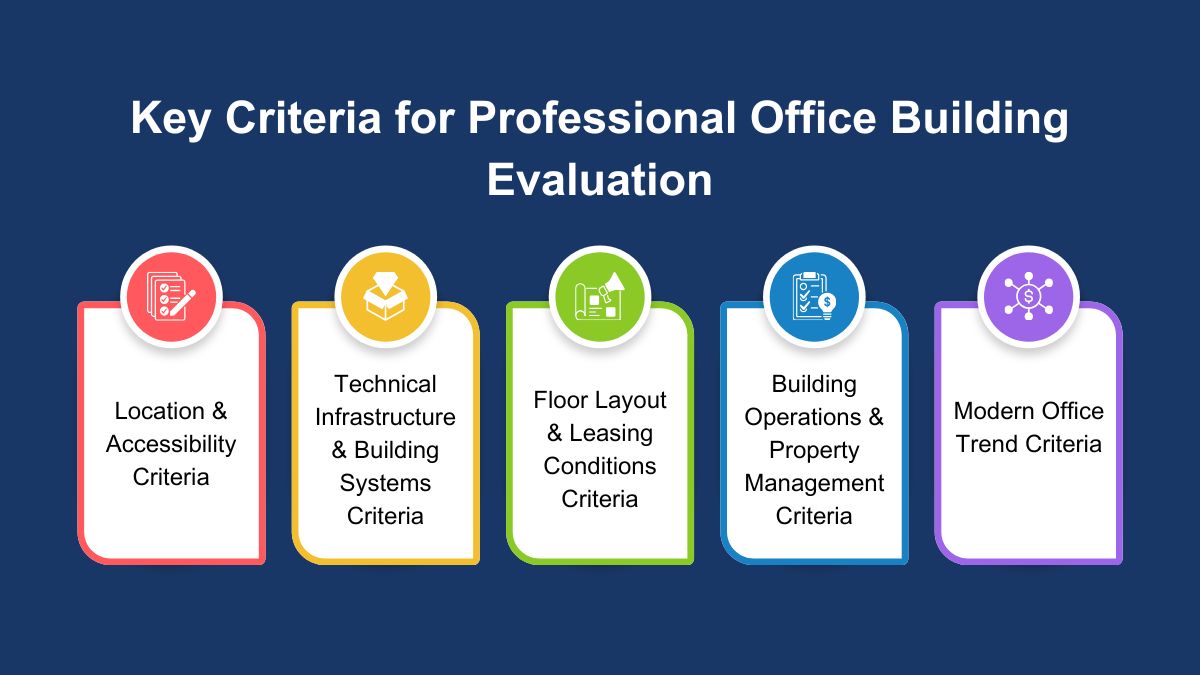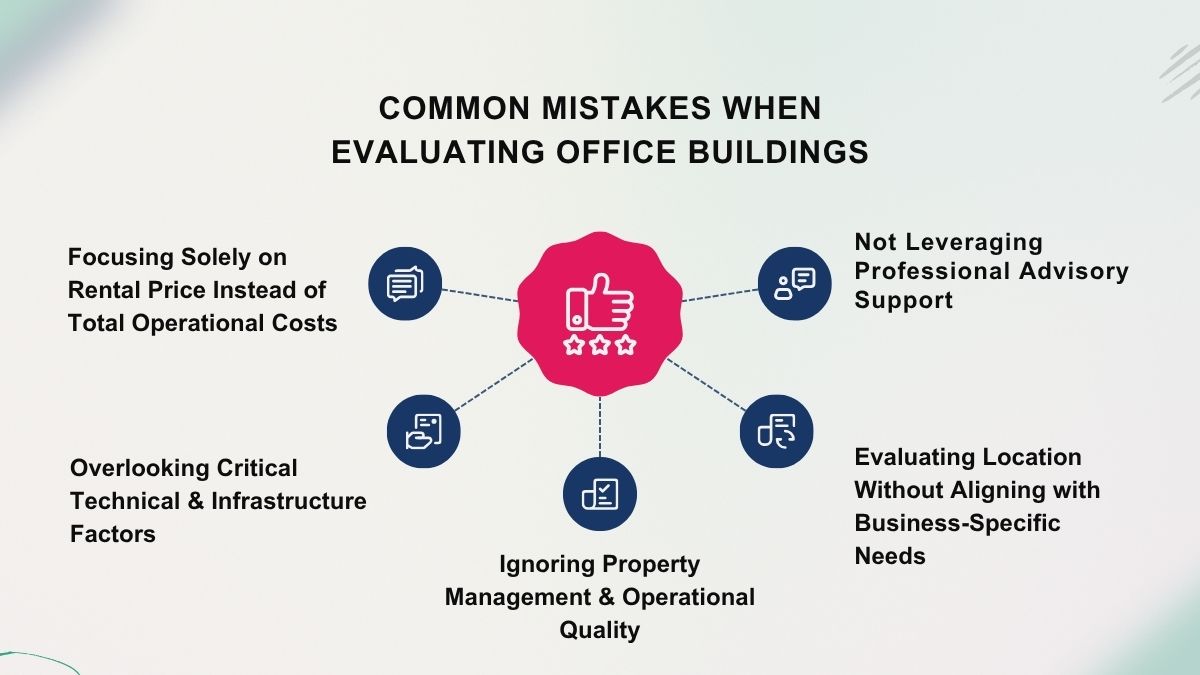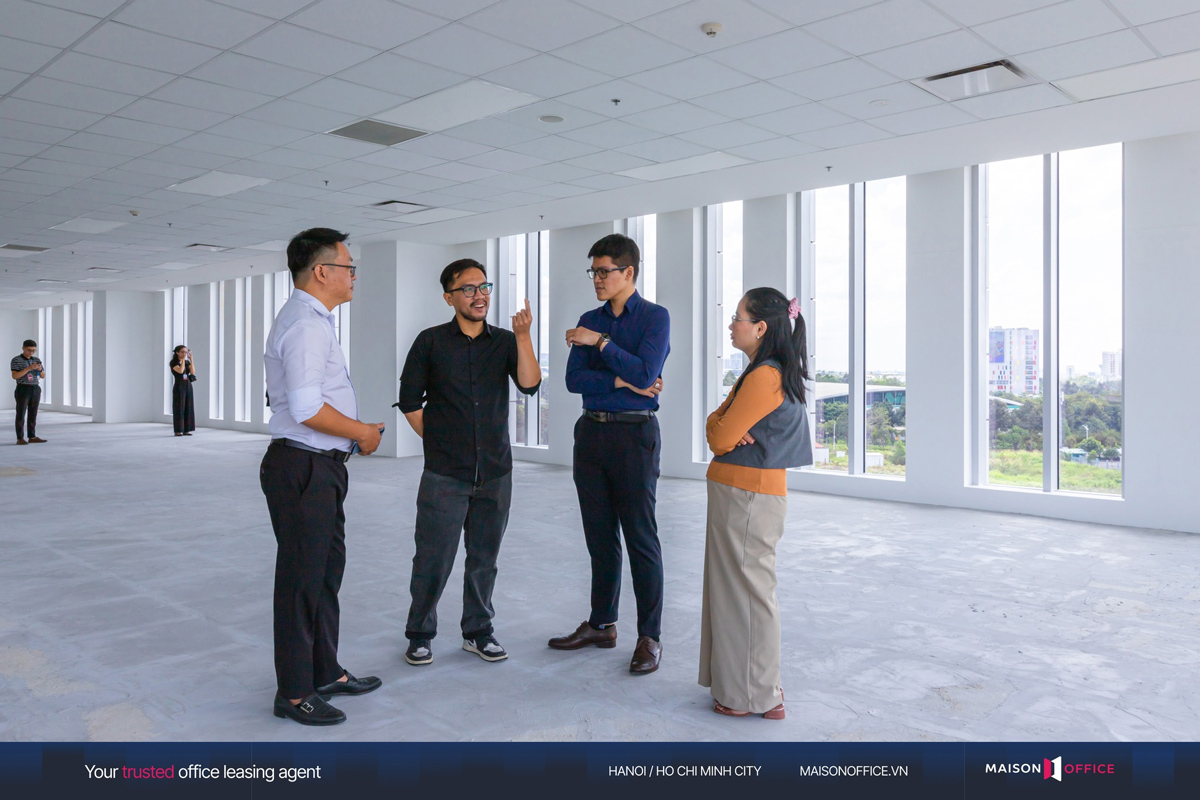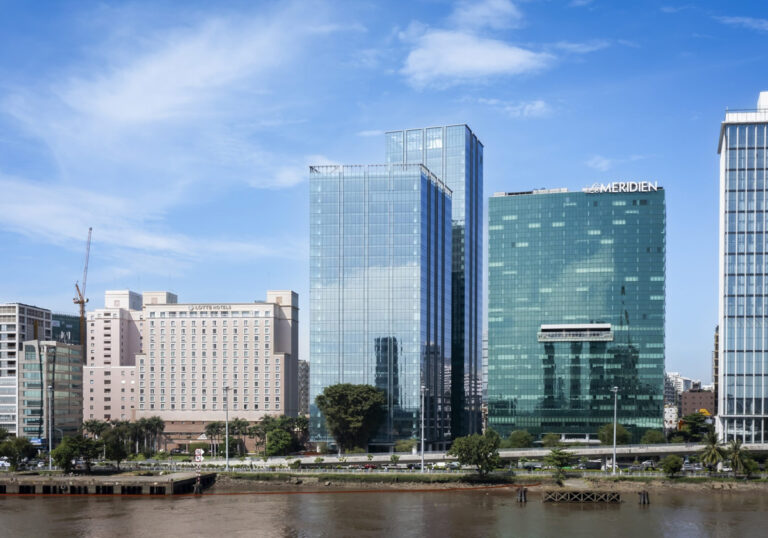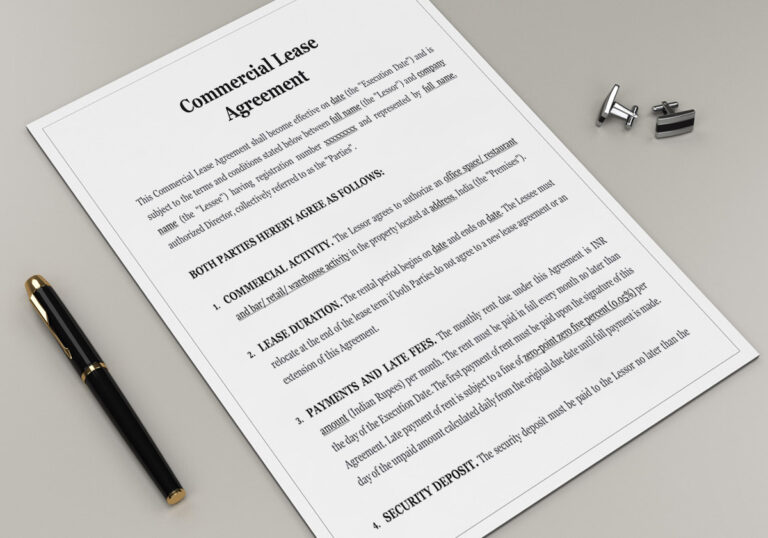30+ Criteria for Evaluating Office Buildings & Lease Spaces

Evaluating an office building before leasing is a critical step that directly impacts a company’s operational efficiency, maintenance costs, and brand image. Drawing from years of experience advising hundreds of clients in Hanoi and Ho Chi Minh City, Maison Office has compiled 30+ professional criteria for assessing office buildings – from location, infrastructure, and operations to modern standards such as BMS (Building Management System) and green certifications – to help businesses make accurate decisions while saving time and budget.
Table of Contents
- 1. Why Should You Evaluate an Office Building Before Leasing?
- 2. Key Criteria for Professional Office Building Evaluation
- 3. Common Mistakes When Evaluating Office Buildings
- 3.1 Focusing Solely on Rental Price Instead of Total Operational Costs
- 3.2 Overlooking Critical Technical & Infrastructure Factors
- 3.3 Ignoring Property Management & Operational Quality
- 3.4 Evaluating Location Without Aligning with Business-Specific Needs
- 3.5 Not Leveraging Professional Advisory Support
- 4. Professional Office Building Evaluation Tips from Maison Office
- 5. Frequently Asked Questions
1. Why Should You Evaluate an Office Building Before Leasing?
Leasing an office space is not just a financial decision—it is a strategic move that shapes your company’s long-term operating costs, workforce productivity, brand positioning, and the ability to attract top talent.
However, based on actual leasing transactions handled by Maison Office, over 60% of first-time tenants tend to skip or inadequately evaluate key building criteria—leading to poor choices, unexpected costs, and operational challenges down the line.
Possible Consequences of Inadequate Building Evaluation:
- Choosing the wrong location may lead to poor client accessibility and inconvenient commutes for staff → negatively impacts recruitment and workplace productivity.
- Substandard infrastructure: low ceilings, weak air-conditioning, and elevator congestion during peak hours → reduces overall office experience.
- Inflexible lease terms, lack of fit-out support, or high overtime charges → lead to hidden operational costs.
- Overlooking the building’s management unit may result in inconsistent service quality, affecting internal operations and client interactions.
Thorough Evaluation Helps Businesses:
- Optimize rental and operational costs
- Ensure long-term business stability
- Secure a high-quality, sustainable workspace
- Take full advantage of landlord incentives and building management support
Instead of making decisions based on intuition or quoted rent alone, businesses should rely on a clear, evidence-based set of evaluation criteria – covering location, infrastructure standards, property services, and modern technology factors.
2. Key Criteria for Professional Office Building Evaluation
To select a suitable office building, businesses must assess the property comprehensively across multiple dimensions—from location and technical infrastructure to property management quality and leasing conditions.
Below is a framework of 30+ essential evaluation criteria, compiled and categorized by Maison Office into five main groups, helping businesses make informed and accurate leasing decisions.
2.1 Location & Accessibility Criteria
Location is a strategic factor that directly influences a company’s brand positioning, customer accessibility, recruitment efficiency, and overall operational performance.
An office building with a prime and convenient location helps optimize time-related costs and creates favorable conditions for the entire business ecosystem.
| Location & Transportation Accessibility Criteria | ||
| 1. Travel time for clients and partners to reach the office | ||
| 2. Level of commuting convenience for employees | ||
| 3. Connectivity to central business districts, airports, and major transport routes | ||
| 4. Traffic congestion in the surrounding area during peak hours | ||
| 5. Proximity to external amenities: banks, restaurants, transaction points | ||
| 6. Area development density: presence of other office buildings nearby | ||
| 7. Current construction or infrastructure disruptions affecting accessibility |
2.2 Technical Infrastructure & Building Systems Criteria
Technical infrastructure is the core foundation that determines the comfort, safety, and long-term operational stability of a business. It is essential to thoroughly assess the building’s design, facilities, and critical engineering systems to ensure they meet professional standards and future scalability.
|
Technical Infrastructure & Building Systems Criteria |
||
| 8. Building architecture and exterior appearance | ||
| 9. Entryways and internal traffic flow: ease of access within the premises | ||
| 10. Reception lobby, waiting areas, and public spaces meeting professional standards | ||
| 11. Elevator system: quantity, speed, and capacity to manage peak traffic | ||
| 12. Cleanliness and maintenance of common areas | ||
| 13. Backup power system: capacity to supply full load during outages | ||
| 14. Basement & parking: vehicle capacity and internal traffic organization | ||
| 15. Reception counter and guest access control areas | ||
| 16. Security and surveillance system: 24/7 monitoring and access control | ||
| 17. On-site amenities: pantry, café, meeting rooms, shared utilities |
2.3 Floor Layout & Leasing Conditions Criteria
Beyond infrastructure, businesses should carefully evaluate the technical details of the leased space to avoid unexpected interior fit-out costs and minimize unnecessary expenses.
| Floor Layout & Leasing Policy Criteria | ||
| 18. Floor shape: is it square and easy to configure, or does it contain many corners and columns? | ||
| 19. Floor plan layout: does it affect space usability or function allocation? | ||
| 20. View, natural lighting, and orientation of the space | ||
| 21. Handover standard: level of completion for ceiling, walls, flooring, etc. | ||
| 22. Placement flexibility for electrical, HVAC, and internet systems | ||
| 23. Central air-conditioning system: capacity and layout of supply/return outlets | ||
| 24. Level of fit-out support provided by the landlord | ||
| 25. Current tenants on the same floor or in the building (tenant mix & community) |
2.4 Building Operations & Property Management Criteria
Property management directly impacts the tenant experience, including issue resolution, maintenance quality, and overall reliability throughout the lease term.
| Building Operations & Management Criteria | ||
| 26. Who is the property management unit? Are they professional, and is there a clear protocol for incident handling? | ||
| 27. Policies for after-hours access and procedures for registering use of building amenities | ||
| 28. Transparency in operations and service fee reporting | ||
| 29. Frequency of maintenance, cleaning, and technical issue resolution |
2.5 Modern Office Trend Criteria
Beyond infrastructure, operations, and leasing policies, there are emerging criteria increasingly prioritized by startups, young enterprises, and international corporations:
| Modern Office Trend Criteria | ||
| 30. Green building certifications: LEED, EDGE, WELL | ||
| 31. Smart building management system (BMS) | ||
| 32. Flexible layout: easily partitioned or expandable spaces | ||
| 33. Shared amenity zones: pantry, lounge, phone booths, creative breakout areas | ||
| 34. Alignment with the tenant’s brand positioning and company culture |
Maison Office Insight: With over 500+ businesses advised in Hanoi and Ho Chi Minh City, we’ve observed that companies who thoroughly evaluate at least the first three groups of criteria tend to have a contract renewal and satisfaction rate exceeding 85%, significantly higher than the market average.
3. Common Mistakes When Evaluating Office Buildings
Evaluating an office building before leasing is a critical step. However, in practice, many businesses – especially first-time office seekers – often fall into common pitfalls.
Below are typical mistakes to avoid in order to ensure the right workspace selection, minimize operational risks, and prevent unnecessary costs.
3.1 Focusing Solely on Rental Price Instead of Total Operational Costs
Many businesses only compare the listed rental rate (VND/m²) while overlooking hidden costs such as:
- Service charges, overtime (OT) fees
- Separate A/C electricity costs, additional service fees
- Unexpected fit-out costs due to inefficient floor layout
–> As a result, actual expenses may far exceed the original budget, disrupting cash flow and operational planning.
3.2 Overlooking Critical Technical & Infrastructure Factors
Key elements like air-conditioning systems, ceiling height, elevator count, and floor load capacity are often evaluated superficially, leading to:
- Insufficient cooling or inability to adjust temperature as needed
- Extra costs for upgrading power, lighting, or IT infrastructure
- Difficulties in interior planning or future expansion
3.3 Ignoring Property Management & Operational Quality
Building management services significantly affect the day-to-day experience of employees and visiting clients.
A common mistake is failing to assess actual management performance, which can result in:
- Delayed responses to technical issues
- Subpar cleaning and maintenance standards
- Unprofessional communication from the property management team
3.4 Evaluating Location Without Aligning with Business-Specific Needs
Many companies choose office buildings simply based on their central location, without analyzing key factors such as:
- Proximity to where core team members live
- Convenience for client visits
- Traffic conditions during peak hours
- Compatibility with the company’s brand positioning and industry image
–> This may lead to recruitment challenges, commuting issues, and reduced team productivity.
3.5 Not Leveraging Professional Advisory Support
A common mistake is reaching out to individual buildings directly without involving an independent consultant, resulting in:
- Lack of comparative data between buildings
- Inaccurate understanding of actual market rental rates
- Difficulty negotiating incentives or fit-out support from the landlord
Maison Office Insight: To avoid these pitfalls, businesses should evaluate office spaces using a standardized set of criteria, conduct on-site inspections, and seek support from professional leasing consultants. With over 500+ corporate clients in Hanoi & Ho Chi Minh City, we recommend assessing at least these five core factors: location – layout – infrastructure – leasing terms – property management.
4. Professional Office Building Evaluation Tips from Maison Office
With over 10 years of experience in office leasing and advisory services across Hanoi and Ho Chi Minh City, Maison Office understands that selecting an office building is not merely a decision about space – it’s a long-term strategic investment for every business.
In reality, many businesses – both large and mid-sized—face challenges in comprehensively evaluating office leasing standards, especially when lacking access to technical details, leasing conditions, or a reliable basis for comparing different buildings. This is exactly why Maison Office exists – as a transparent, independent, and dedicated consulting partner throughout the office search process.
We go beyond simply providing a list of available spaces. Our team supports clients with:
- In-depth analysis and comparison of buildings based on each company’s specific operational needs
- Workplace layout consultation tailored to your budget and business development goals
- Lease term negotiation to secure the most favorable conditions with landlords
- Contract review to ensure your legal and operational rights are fully protected
- On-site inspections with a professional evaluation checklist to guide your decision-making process
 |
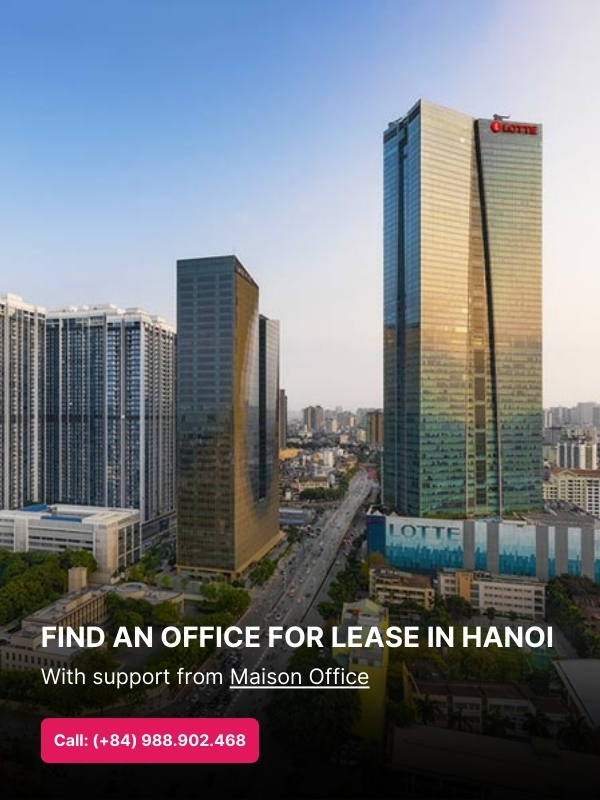 |
Maison Office is currently the trusted office leasing advisor for over 500+ domestic and international companies – ranging from tech startups and financial service firms to multinational corporations.
We are committed to putting the client’s needs and interests first, with no bias toward any landlord or building.
Contact Maison Office today for free consultation, site tours, and a detailed side-by-side building comparison:
- Hotline: 098.890.2468
- Website: https://maisonoffice.vn
- Email: info@maisonoffice.vn
5. Frequently Asked Questions
5.1 Which criteria should businesses prioritize when evaluating an office building?
You don’t always need to assess all 30+ criteria. Businesses should focus on the five core factors: location – floor layout – technical systems – property management – leasing conditions. These directly impact operating costs, efficiency, and employee experience.
5.2 Is it advisable to lease office space in a high-tech park or new urban area?
It depends on your industry and business model. For tech companies, software firms, or R&D centers, high-tech parks offer a specialized environment, reasonable rental costs, and collaboration opportunities. However, if your business frequently hosts clients or holds meetings, central business districts are better for accessibility and brand positioning.
5.3 When is the best time to start surveying and negotiating a new office lease?
Ideally, start 2–3 months before your intended move-in date. This gives you sufficient time to compare multiple buildings, negotiate favorable terms, and plan fit-out works without pressure or delays.

